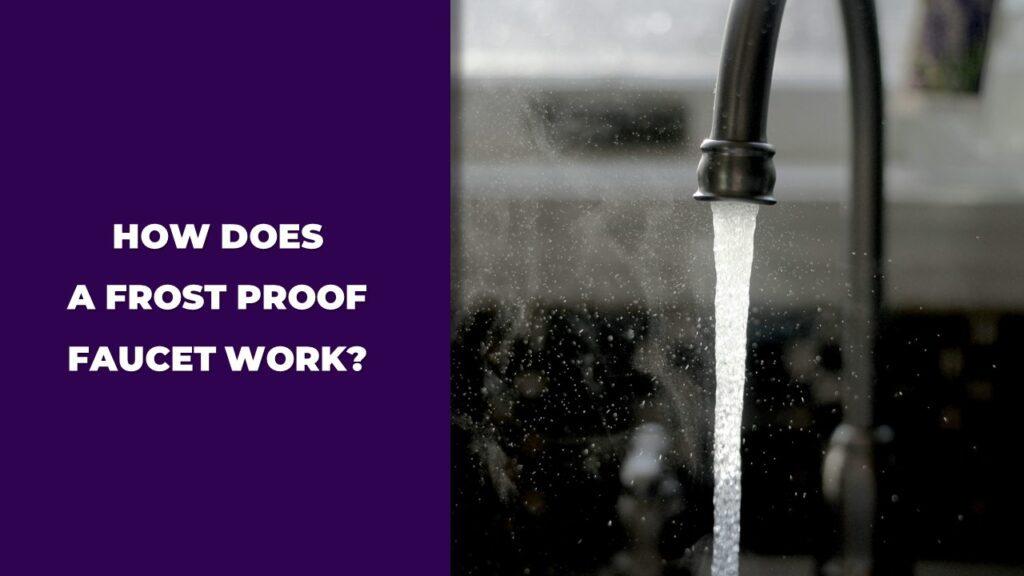
A frost-proof faucet works by tucking the shut-off valve deep inside your warm house, where freezing temperatures can’t reach. When you turn the faucet off, any leftover water drains out from the exposed part outside. No water sitting there means no freezing, no pressure buildup, and no burst pipes in the dead of winter.
If you’re a homeowner, a DIYer, or just trying to avoid a costly plumbing disaster when the weather turns cold, this guide has your back. We’ll walk through exactly how frost-proof faucets do their job, how they’re installed, what can go wrong, and simple tips to keep them working for years to come. Let’s dive in!
What Is a Frost Proof Faucet?
A frost-proof faucet is a special outdoor tap designed to prevent freezing in cold weather. Unlike regular faucets, the shut-off valve is placed inside the warm part of your home. When you turn off the handle, the water drains out of the exposed pipe, so there’s nothing left to freeze. That means no cracked pipes and no costly leaks when winter hits.
Think of it like this: Your regular outdoor faucet? It’s right there, fighting the cold head-on. A frost-proof faucet? It’s smart, hiding the critical parts safely inside where it’s warm. That simple design can save you from a whole lot of trouble, especially if you’ve ever had a burst pipe flood your basement.
So, if you live somewhere that gets chilly, a frost-proof faucet isn’t just nice to have; it’s a must.
How Does a Frost Proof Faucet Work? (Step-By-Step Breakdown)
A frost-proof faucet works by keeping water away from the cold. The shut-off valve is placed deep inside your home, where it’s warm, and any leftover water drains out, so it doesn’t freeze and cause damage.
Here’s the simple breakdown:
- The hidden shut-off valve sits inside your warm house, far from the freezing air.
- A long stem runs from the valve to the spout outside, usually 4 to 24 inches long.
- The pipe is angled slightly down so water drains completely after use.
- When you turn the faucet off, any water left in the outdoor part drains out—nothing is left to freeze.
- A vacuum breaker prevents water from the hose from getting sucked back into your home’s clean water supply.
- Compared to standard faucets, frost-proof faucets are built for cold weather and won’t freeze up like regular hose bibs.
The main thing here is really just smart design. A regular faucet has its shut-off valve right behind the handle, and that part sits in the cold. A frost-proof faucet pulls that valve inside, keeping it safe and warm. When you turn off the water, gravity helps drain the water left in the outdoor part of the faucet. That way, there’s nothing sitting around to freeze, crack the pipe, and flood your basement. Simple, smart, and effective—just how outdoor plumbing should be.
Key Components of a Frost Proof Faucet
A frost-proof faucet has a few simple parts that work together to keep your water flowing safely in winter. Here’s what makes it different:
- Handle: What you turn to open and close the faucet. It’s outside, but it connects to the valve inside your home.
- Spout: The part where the water comes out. It’s usually threaded so you can attach a hose.
- Long Stem (Barrel): A pipe that runs from the handle outside to the shut-off valve inside the house. This stem can be several inches long, depending on the wall thickness.
- Shut-Off Valve: The heart of the frost-proof design. It’s deep inside your warm home and controls the flow of water.
- Washer or Cartridge: Creates a watertight seal when the faucet is closed, preventing drips and leaks.
- Vacuum Breaker (Anti-Siphon): Stops water from flowing backward into your home’s water supply. This keeps things safe, especially when using a hose for yard work.
- Slope: The slight downward angle of the faucet that helps drain water when the faucet is turned off. It’s a small detail, but it makes a big difference.
- Optional Shut-Off Valve: Some setups also include a secondary valve inside your home for extra protection.
Each part plays a role in making sure your faucet doesn’t freeze, leak, or cause headaches when winter comes around. When they all work together, they give you peace of mind, knowing your outdoor plumbing is safe.
How To Install A Frost Proof Faucet (Step-By-Step)
A frost-proof faucet is installed by drilling a hole through the wall, sliding the long stem at a slight angle, and hooking it up to your home’s water supply inside. The key is to make sure water drains out after every use so you’re not left with a frozen, burst pipe when it gets cold.
Let’s break it down so it actually makes sense, because I know this stuff can feel confusing if you’ve never done it before:
- Step 1: Pick the Spot: You’ll need a good spot on the outside of your house where the faucet will go. Check inside to make sure you can reach the water line easily, because you’ll need to tap into it.
- Step 2: Drill a Hole: Yeah, it sounds scary—drilling through your house wall. But take it slow. You’ll need a hole about 1 1/8 inches wide to fit the faucet barrel.
- Step 3: Put in the Faucet: Slide the long stem of the faucet through the hole. Make sure it’s angled slightly down toward the outside. That little tilt makes all the difference, so water can drain and not get stuck in the pipe when it’s freezing outside.
- Step 4: Screw It In: Attach the faucet flange tightly to the wall. This is what keeps it snug and leak-free.
- Step 5: Connect to the Water: Now you go inside and hook the faucet up to your water line. Depending on what pipes you have—copper, PEX, or those old-school galvanized pipes, you’ll use different connectors. If you’re using SharkBite push-fittings, it’s pretty simple.
- Step 6: Test Everything: Turn the water on and check for leaks. Inside, outside, everywhere. A slow drip today can turn into a major headache later.
Why Hiring a Plumber Might Be Worth It for Proper Installation
Sometimes it’s just easier to hand the job over to a pro. A plumber knows how to get that downward slope just right, how to connect different pipes without leaks, and how to seal everything up so you don’t end up with water dripping inside your wall.
Sure, you can DIY it if you feel confident, but if the thought of drilling through your wall or messing with water lines makes you nervous, calling in a plumber can save you a lot of stress. They’ve done this kind of thing dozens of times, so they’ll know how to avoid those little mistakes that can cause big problems later.
Can Frost-Proof Faucets Still Freeze?
Here’s the thing no one likes to hear: Yes, a frost-proof faucet can still freeze if it’s not installed or used the right way. It’s frustrating, right? You buy a frost-proof faucet to avoid freezing issues, and then it can still happen.
One of the biggest mistakes is leaving your hose attached during winter. That traps water in the faucet, and when temperatures drop, it turns to ice. Ice expands, cracks the pipe, and next thing you know, you’ve got a mess on your hands.
Another problem is when the faucet isn’t angled downward enough. If it’s not sloped, water won’t drain out, and that leftover water can freeze. Even with a frost-proof faucet, that little slope is everything.
Sometimes the faucet doesn’t reach far enough inside your house, so the shut-off valve is still exposed to cold air. If the valve isn’t tucked away in the warm part of the house, it’s still at risk of freezing.
And let’s not forget worn-out parts like the vacuum breaker or washer. If they fail, water can sneak back into the pipe, and once that freezes, you’re in trouble. It’s why a quick check before winter—making sure everything looks good, no leaks, no cracks—can save you a lot of heartache later.
Common Problems With Frost Proof Faucets (And How to Fix Them)
Frost-proof faucets can still have issues, especially if they’re not installed right or if parts wear out. The most common problems are leaks, freezing, and drainage issues—but the good news is, most of these can be fixed with simple steps.
Here’s a breakdown of common frost-proof faucet problems and how to tackle them:
- Leaky Spout: Usually caused by a worn washer or a damaged valve seat. You’ll need to replace the washer or the seat to stop the leak.
- Draining Issues: If water doesn’t drain out after turning off the faucet, check the slope of the pipe. The faucet should tilt slightly downward toward the outside. No slope means water stays in the pipe, and that’s asking for trouble.
- Vacuum Breaker Leaks: If water is dripping from the vacuum breaker, it might be cracked or the diaphragm could be worn. Swap out the part, and you’re good to go.
- Frozen Faucet: If your frost-proof faucet still freezes, it’s often because a hose was left attached, the slope wasn’t right, or the faucet wasn’t long enough to reach the warm part of the house. Check all these factors if you run into problems.
- Handle Hard to Turn: This usually means the stem needs a little lubrication, or the washer has worn out and needs replacing.
A frost-proof faucet is a great tool, but like anything, it needs a little care. Most problems have a simple fix, as long as you catch them early.
Maintenance Tips to Keep Your Frost Proof Faucet Working Year After Year
A frost-proof faucet lasts longer when you give it a little attention. Regular checks, cleaning, and basic care can save you from expensive repairs later.
Here are some easy maintenance tips to keep your faucet working smoothly:
- Disconnect Hoses in Winter: Always remove hoses when the weather turns cold. Leaving a hose attached traps water and can lead to freezing and burst pipes.
- Check for Leaks: Every spring and fall, check for leaks around the handle, spout, and where the faucet connects to the wall. If you see drips, fix them before they get worse.
- Inspect the Vacuum Breaker: Make sure the vacuum breaker isn’t cracked or worn out. This small part prevents water from being sucked back into your house.
- Lubricate the Handle: A stiff handle is a sign that it needs a little care. A few drops of silicone lubricant can make it turn easily again.
- Seal Around the Pipe: If you see gaps where the faucet meets the wall, seal them up. Cold air can sneak in, raising the risk of freezing.
- Slope Check: Check the angle of the faucet. If it’s not sloped down slightly, water won’t drain properly.
Think of these steps as small habits that protect your faucet for years to come. It’s like giving your plumbing a quick health check—catch the little stuff before it turns into a big headache.
Frost Proof Faucets vs. Regular Faucets: What’s the Difference?
A frost-proof faucet is built to handle freezing temperatures by keeping the shut-off valve inside your warm home, while a regular outdoor faucet has its shut-off valve right behind the handle, where it’s exposed to the cold. This difference is what makes frost-proof faucets so much safer in winter.
Here’s a quick side-by-side comparison:
| Feature | Frost Proof Faucet | Regular Outdoor Faucet |
| Valve location | Inside warm area of home | Just behind faucet handle |
| Freeze resistance | High (if installed correctly) | Low |
| Requires draining? | No (drains automatically) | Yes (manual draining needed) |
| Hose removal needed? | Yes | Yes |
| Backflow protection | Yes (vacuum breaker) | Not always |
Frost-proof faucets might cost a bit more upfront, but they’re worth it for the peace of mind. They’re built to protect your home from the hassle of frozen pipes and unexpected leaks.
Cost of Frost Proof Faucets (And Long-Term Savings)
A frost-proof faucet typically costs $25 to $60, depending on size and features like a vacuum breaker. Professional installation runs between $120 and $200, depending on your location and the complexity of the job.
Now, I know what you’re thinking: Is this really worth it? You’re standing in the hardware store, holding that faucet, feeling unsure. The price tag feels like a lot for “just a faucet,” and the thought of hiring a plumber makes you pause.
But here’s the reality: if a regular outdoor faucet freezes and bursts, you’re looking at $2,000 to $5,000 in damage—maybe more if you’ve got finished walls, wood floors, or an old house. Even a small leak, dripping quietly in the background, can waste 10 gallons of water a day. That adds up to over 3,600 gallons a year—and trust me, you’ll feel that on your water bill.
So yes, a frost-proof faucet is an upfront investment. But it’s also protection for your home and your wallet. It’s the difference between a cozy winter inside and a nightmare of soaked carpets, ruined drywall, and a flooded basement. And when you break it down like that, spending a little now to save a whole lot later? That just makes sense.
Final Thoughts
If you live in a place where winters hit hard, a frost-proof faucet is a must-have. It protects your home’s plumbing from freezing and bursting pipes by keeping the shut-off valve inside, where it stays warm. That smart design gives you a safer, more reliable way to get water outdoors, even in cold weather.
A frost-proof faucet isn’t just a convenience, it’s a way to prevent costly water damage and major headaches. Draining water out of the exposed pipe after each use helps avoid frozen pipes that can crack, leak, and flood your home.
Installing a frost-proof faucet is one of those simple upgrades that pays off for years. Whether you’re a DIYer or you hire a plumber, it’s worth it to keep your plumbing safe when the temperatures drop.
Related FAQs
Can I leave my hose connected to a frost-proof faucet in winter?
No, you should always disconnect the hose in winter. Leaving it attached traps water in the faucet, which can freeze and cause damage.
Do I still need to shut off my home’s water with a frost-proof faucet?
Usually not. The shut-off valve is already inside your warm home, so water stays safe from freezing.
How long does a frost-proof faucet last?
A good frost-proof faucet can last 10–20 years or more with proper care and maintenance.
Can I replace the washer or vacuum breaker myself?
Yes, most homeowners can handle it. Just make sure you get the right replacement parts and follow basic repair steps.
What happens if I install the faucet without a slope?
If there’s no slope, water won’t drain out fully. That leftover water can freeze, crack the pipe, and cause leaks.

Dylan Foster is a family man with years of hands-on experience in plumbing, household maintenance, and fixing everyday issues around the home. A former plumber, Dylan knows what it’s like to deal with tricky leaks, worn-out parts, and all the little problems that pop up in a house. From plumbing repairs to kitchen fixes and garden hose setups, he’s done it all. Dylan shares real-world solutions to help others keep their homes running smoothly and avoid costly mistakes.




